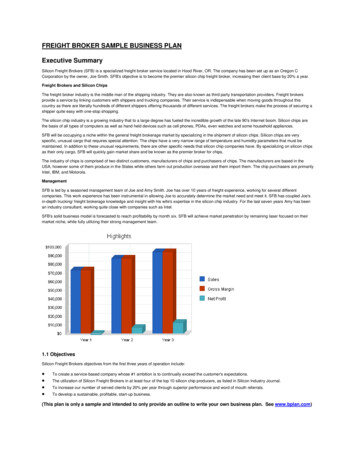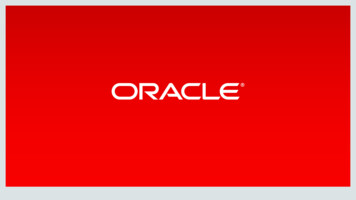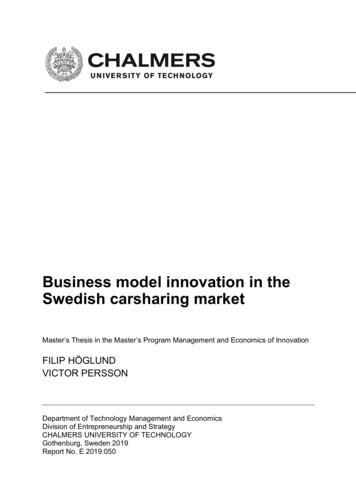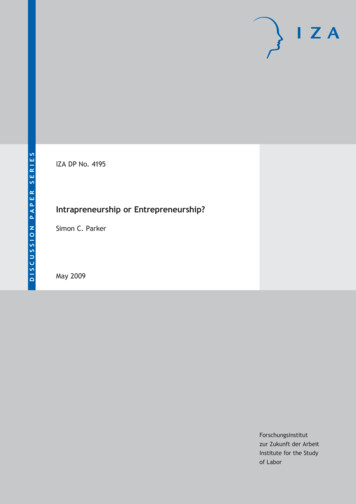Transcription
How to innovate theSilicon Valley wayTapping into the Silicon Valley innovation ecosystem
How to innovate the Silicon Valley wayDoblin, the innovation unit of Monitor Deloitte, specializes in helping companies anticipate andseize new business opportunities. It is one of the few innovation firms that goes beyond opportunity analysis and portfolio management by also working with clients to generate and build newofferings and businesses. Doblin helps clients set innovation strategy; design, build, and launch innovations; and become better innovators by developing their own signature innovation capabilities, systems, and structures that are specific to each enterprise. Learn more at www.doblin.com.Bridge by Deloitte is a subscription-based digital platform that helps enterprises connect directlywith start-ups, monitor the innovation landscape, and foster new ideas together. It combines thesector-specific knowledge and depth of Deloitte insights with powerful algorithms to scan the innovation ecosystem for start-up partners based on specified criteria. Learn more at www.deloitte.com/us/bridge.
Tapping into the Silicon Valley innovation ecosystemContentsExecutive summary 2Silicon Valley 3An important center of innovation andtechnology disruptionThe benefits of participating in innovationecosystems 7Lessons from successful innovators 9Challenges and risks 13Steps for effective innovation in Silicon Valley 15The ecosystem advantage 181
How to innovate the Silicon Valley wayExecutive summarySilicon Valley has been and continues to be one of the world’s most important centers of innovation and technology disruption. Given the Valley’s nearlyunique set of assets—the presence of technology giants, world-class universities, abundant venture capital, and a hypercompetitive yet collaborative culture that celebrates both risk and failure—the Northern California region’srecipe for innovation has rarely been replicated. Large enterprises are increasingly venturing into the Valley to draw upon “outside-in” innovation, but theyoften stumble due to cultural, structural, and regulatory hurdles. To be able toharness Silicon Valley’s innovation ecosystem to their advantage, enterprisesshould have clearly stated objectives and direction, as well as a deep understanding of the local environment.2
Tapping into the Silicon Valley innovation ecosystemSilicon ValleyAn important center of innovation andtechnology disruptionSILICON Valley has been driving innovation anddisruption for several decades, and throughthe beginning of the 21st century, it continues to be one of the world’s most important centersof innovation and technology disruption (figure 1).The region is notable for its combination of widelyavailable capital and rapid scale-up of commerciallyviable “intellectual property (IP)”. More than onethird of the 141 companies in the Americas, Europe,and Asia Pacific that grew to a valuation of greaterthan 1 billion between 2010 and 2015 were locatedin the Bay Area, a striking testament to the area’sability to accelerate commercial success.1 Perhapsfor this reason, 61 percent of companies with innovation centers have a presence in Silicon Valley.2The Northern California region’s recipe for innovation has rarely been replicated. Given Silicon Valley’s largely unique set of assets—the presence oftechnology giants, world-class universities, abun-Figure 1. Silicon Valley belsApplePhoneOEMsFurther disruption waves ahead.iOSConnected cars and autonomousvehiclesExamples: Tesla’s ability to make overthe air changes to vehicles, Google’sdriverless car projectAndroid 12BMusic 75BMobile devicesContentcreatorsNetflix 4B 45BSilicon ValleyecosystemMoviesMovieretailers 4BTaxi & limoHospitalityAirbnb 15BAlternatives to traditional bankingExamples: Lending Club and Prosperwhich enable lending between users,Stripe that handles online l taxi firmsHotelchainsPrintmediaBig brandsDigital health and advanced roboticsExamples: Health information platformslike Apple Healthkit, advanced roboticsdevelopment leading to robotic surgeryBroadcastDisruptedDisruptorsRevenue disruptedSource: Deloitte analysis.Graphic: Deloitte University Press DUPress.com3
How to innovate the Silicon Valley wayTECHNOLOGY INNOVATION HUBS WORLDWIDEA few other innovation hubs are emerging that share a number of characteristics with Silicon Valley thatmake them a fertile ground for innovation: New York (for financial technology), Tel Aviv (for security),and Austin (for digital health), along with other locations such as Boston, Paris, London, and Berlin. All ofthese hubs are characterized by a multitude of start-ups supported by leading academic and researchinstitutions, easy access to venture funds and accelerators, ready availability of talent, and an open,collaborative ecosystem that enables innovation.Capitalizing on externalinnovation: How arelarge enterprises tappinginto Silicon Valley?dant venture capital, and a hypercompetitive yetcollaborative culture that celebrates both risk andfailure—the massive scale of innovation in the areashould not be a surprise.“Many large, successful companies are creating offices in California’s Silicon Valley tospot big new trends and learn how they cantransform their organization[s] in ways theycouldn’t otherwise imagine. It’s no longergood enough to wait for change to cometo your industry; you need to be out therewhere it’s happening. And a lot is happening in Silicon Valley.”Organizations from across the globe are expendinga significant and increasing amount of resources tocapture external innovation from innovation hotbeds such as Silicon Valley. According to a surveyof Silicon Valley-based CEOs, the main advantagesof doing business in the Valley are its entrepreneurial mind-set (83 percent), access to skilled labor (81percent), and proximity to customers and competitors (60 percent).4 When companies are looking to—Harvard Business Review (2013)3Figure 2. Geographic distribution of companies that entered the “billion dollar club” (2010–2015)CountryNumber ofcompaniesUnited States89China20India6Others26Region inthe USNumber ofcompaniesBay Area52NY/NJ13LA area6Others18Source: CB Insights, The unicorn list: Current private companies valued at 1B and companies, accessed January 2016.Graphic: Deloitte University Press DUPress.com4
Tapping into the Silicon Valley innovation ecosystemFigure 3. Enterprises across multiple industries and geographies are turning to innovation hotspots tohelp solve confounding strategic problems5Small and nimble Bay Areaoutpost to enhance digitalengagement (2013)San Francisco-basedVenture Accelerator (2014)NestléSiemensWells FargoDisneyBaidu80% of Siemens’ projects involvestartups (33% in Silicon Valley)and 20% involve universitiesDisney Acceleratorprogram SiliconValley/SoCal (2014)HondaSamsungBaidu committed toinvesting 300M in theSilicon Valley lab overthe next 5 yearsSource: Deloitte analysis.Honda SiliconValley lab openedin May 2011Samsung’s multi-prongedopen innovation platformin Silicon Valley (2013/14)Graphic: Deloitte University Press DUPress.com Corporate accelerators are being establishedby companies to nurture start-ups and scoutfor innovative ideas. Corporate accelerators aresimilar to traditional accelerators except that,while traditional accelerators focus on amplifying returns on equity investments, corporate accelerators are set up for harnessing innovation.make strategic investments, the Valley providesthem with easy access to potential collaborators.Proximity to start-ups can also make the innovationprocess faster and more efficient.The movement westward is not limited to companies within a certain industry or geography (figure3). Be it Nestlé’s small and nimble Bay Area outpostto enhance digital engagement6 or Samsung’s multipronged open innovation initiatives in the SiliconValley,7 companies from all across the globe and invarious industries are establishing operations in theValley.More than one-third ofthe 141 companies inthe Americas, Europe,and Asia Pacific thatgrew to a valuation ofgreater than 1 billionbetween 2010 and2015 were locatedin the Bay Area.These corporations are exploring multiple optionsto access the Silicon Valley innovation ecosystem: Collaborative arrangements can be set upwith players in Silicon Valley’s highly diversetechnology ecosystem. These can include licensing agreements for license transfers or fee-basedarrangements, as well as project-based partnerships or joint investments. BMW, one of theearlier arrivals in the Valley, has benefited fromits partnership with Apple Inc.8 These collaborative agreements could represent specific projectbased partnerships or longer-term “big bets.”5
How to innovate the Silicon Valley wayACCELERATOR ADOPTION MODELSEnterprises can choose to operate the accelerator in-house, or outsource the accelerator’s operationsto a partner such as Techstars, LMarks, or Nest. In the past three years, more than 100 corporateaccelerators have been launched globally.12 Our analysis suggests that roughly half of these acceleratorshave used a partner to manage their operations. Partners may charge several hundred thousand dollarsto set up and run an accelerator.Companies may also opt to sponsor existing accelerator programs. For example, EMC sponsorsSigmaLabs.13 As might be expected, a sponsorship model gives corporations less influence on anaccelerator’s strategy and functioning than an in-house or outsourced model.tion, in which a company acquires start-ups orlarger players in areas of interest, can provideaccess to cutting-edge technology. Venture capitalists closed 279 deals in Silicon Valley in thefirst quarter of 2016, and 286 in the last quarterof 2015.11Enterprises can utilize multiple models to set upaccelerators (see sidebar, “Accelerator adoptionmodels”).9 Corporate venture capital (CVC) funds canbe used to provide market development supportand enable access to technology breakthroughs.CVC funds can be set up as semi-captive fundsthat are open to other industrial partners, or ascaptive funds that are wholly owned by the parent. CVC has become an important avenue foroutside-in innovation, accounting for 33 percentof total venture capital deployments in Q4 2014,up 20 percent from Q1 2013.10In practice, many companies focus largely on oneto-one partnerships to drive innovation in SiliconValley. However, while these partnerships may helpcompanies in their innovation efforts, executivesmay want to evaluate them as a complement to abroader innovation program, going beyond shortterm transactional partnerships to take full advantage of distributed innovation. Acquisitions within core and adjacent markets to complement internal organic innova-6
Tapping into the Silicon Valley innovation ecosystemThe benefits of participatingin innovation ecosystemsWHY should enterprises give up transactional approaches in favor of dynamic,ecosystem-led innovation? The answerlies in the enormous performance pressure companies are experiencing today in an environment thatputs a premium on innovation. In a worldthat is increasinglycharacterized by technologicaldisruptionand a highly volatiledemand for new products and services, corporations face the needto be more responsiveand agile than ever.the means of any single actor (or a near-homogenous group of actors). Innovation thinkers, notablyJohn Hagel, have emphasized the importance ofsuch ecosystems, suggesting they provide the mostsustained and important benefits to those businesses that create,lead, and participatein them.15 This rise ofecosystems is forcingleading organizationsto rethink their strategies, business models, operating models,core capabilities, valuecreation and capturesystems, and organizationalmodels.16Companies can nolonger expect to succeed while operatingin silos.New cross-industryecosystems are evolvingto enable co-createdsolutions and to servemarkets in ways thatare beyond the meansof any single actor (ora near-homogenousgroup of actors).The findings of the2013 Shift Index studyhighlight the increasing difficulty of creating shareholder valueover time. Between1965 and 2012, UScompanies experienceda 75 percent decline in return on assets. Moreover,the average tenure of a company on the S&P 500 hasdeclined from 61 to 18 years over the past 55 years.14While multiple wavesof innovation haveoriginated from SiliconValley over the years, the current one is particularlysignificant because it is driving the creation ofecosystems that cross industry borders. See thesidebar, “Disruption and evolving ecosystems inthe automobile industry,” for an example of howdisruption in one industry is impacting a wide arrayof players far beyond companies in that industry.In addition, driven by large-scale digitization andconnectivity, longstanding industry and marketboundaries continue to blur. New cross-industryecosystems are evolving to enable co-created solutions and to serve markets in ways that are beyond7
How to innovate the Silicon Valley wayDISRUPTION AND EVOLVING ECOSYSTEMS IN THE AUTOMOBILE INDUSTRYGone are the days when cars were about engines, camshafts, or cylinder blocks. Today, between10–25 percent of the cost of making cars comes from software.17 The new Ford GT has 10 millionlines of code—3 million more than the code found in a Boeing 787 Dreamliner.18Tesla’s ability to remotely make changes to its vehicles and Google’s driverless project are leadingthe next wave of disruption in the auto industry. Silicon Valley players such as Apple Inc., Uber,and Google have been making advances into the automobile space; as a result, most major autocompanies (such as Ford, Honda, and BMW) and suppliers (such as Robert Bosch GmbH and Delphi)have established a presence in the Valley to be near the automotive R&D taking place.19 Toyota,for example, is investing 1 billion in a Silicon Valley-based research company to develop artificialintelligence and robotics.20A recent Deloitte publication, The Future of Mobility, describes how this global transformation of theauto industry has implications for not only carmakers but also an array of players, including energycompanies, insurers, mobility fleet operations such as ridesharing services, smartphone providers,sensor technology vendors, health care providers, and even government. The article highlights theneed to shift from a business model based on products (in this case, the vehicle) to one based onthe mobility experience.21 The evolving mobility ecosystem presents opportunities to create valuefor both established companies and new entrants. Network effects will likely drive the formation ofspecialized ecosystems within the mobility ecosystem, which, in time, will likely consolidate, leadingto a strong, concentrated group of platform providers.22 As in other ecosystems, being the firstmover is key to capturing value—think Amazon in online retailing and Google in online advertising—and followers, however fast, often risk being left behind.Ecosystems are dynamic and co-evolving communities of diverse actors who create and capture newvalue through both collaboration and competition.238
Tapping into the Silicon Valley innovation ecosystemLessons from successfulinnovatorsFGE: The billion-dollar start-upwithin a global enterpriseIGURE 4 illustrates Doblin’s Ten Types of Innovation framework, with examples of companies that have used each type of innovation.It shows how various companies have used eachtype of innovation in their Silicon Valley-basedoperations.24 That said, most successful companies have used more than one type of innovationto drive results. The following case studies explorein detail how two companies have integrated multiple types of innovation to harness innovation inSilicon Valley.GE considers the “Industrial Internet”—a termcoined by GE to refer to the integration of complexphysical machinery with networked sensors andsoftware—to be its next fundamental growth opportunity. However, software companies with stronganalytics capabilities present a threat to GE, as datafeeds allow them to analyze and predict failures. In2012, GE launched its Industrial Internet initia-Figure 4. Ten types of innovation: Examples of successful innovation outpostsEXPERIENCEOFFERINGCONFIGURATIONHow you.Such as.make moneyLendingClubPartnered with Google to pilot financing to itsresellers, etcNetworkconnect with others tocreate valueSAPBusiness analysts, consultants, and developersin the business process expert communityStructurealign your talentand assetsSwisscom AGBrings winners of its start-up challenge toSilicon Valley for an acceleration programProcessuse signature or superiormethods to do your workZapposZappos Labs operates in one-week sprints; the AskZappos service was completed in only 12 weeksProduct Performanceemploy distinguishingNovartisfeatures and functionalityPartnering with Google to develop “smart”lenses to help track blood glucose levelsProduct Systemcreate complementaryproducts and servicesStaplesIts San Mateo-based innovation lab launcheda digital wallet in nine weeksServicesupport and enhance thevalue of your offeringsCapital OneCapital One Labs has been aiding digitalservices with banking APIsChanneldeliver your offerings tocustomers and usersTarget60% of holiday season traffic on Target.comcomes from mobileBrandrepresent your offeringsand businessPearsonEvolving its brand by exploring ed-techpartnerships through RocketSpaceCustomer Engagementfoster distinctiveinteractionsAXAAXA Lab is testing customized emails based onthe Hearsay social platformSource: Doblin.Graphic: Deloitte University Press DUPress.com9
How to innovate the Silicon Valley wayFigure 5. GE: Forming a start-up within a global corporation25CrowdsourceScale innovation viacrowdsourcingpartnershipsBUSINESS MODEL-CENTRICLean start-upFast and agileapproach toinnovation (FastWorks)Integrated solutionsEvolution into a softwareand analytics companyPLATFORM-CENTRICEXPERIENCE-CENTRICSoftware CoEDisrupting the traditional businessunit-centric power structures with thesoftware “start-up”Industrial InternetExpanded vision andcustomer-driven brand playSource: Doblin.Graphic: Deloitte University Press DUPress.comPROCESStive, committing to spend 1 billion over a period ofthree years to build solutions.26 As part of this initiative, GE established its Silicon Valley-based Software Center, part of GE Global Research, as a startup. After achieving reasonable scale, GE broughttogether the Software Center, the Intelligent Platforms business, its Global IT and commercial software teams, and Wurldtech (a provider of industrialsecurity systems) under the GE Digital umbrella inSeptember 2015.27GE’s Software Center embraced “FastWorks”—afast approach to innovation based on Eric Ries’sLean Start-Up framework—which was then alsobeing implemented across the broader company.In adopting this approach, leaders were aiming tomake GE more agile to shorten the time to marketand increase productivity. The FastWorks modeof operation starkly contrasts with GE’s traditional mode, which was anchored on Lean Six Sigma.For instance, historically, products were kept hidden until their release; now, customers are part of aproduct’s evolution. As Kevin Nolan, vice presidentof technology for GE Appliances, put it, “With FastWorks, we’re learning that speed is our competitiveadvantage. How do we become much more openand collaborative with the customer base? You can’tdo that if you want to be secretive.”29 To overcomeorganizational resistance to the new approach, GEstarted by working with business units, such as theSoftware Center and later GE Digital, that were willing to adopt the agile methodology; this then created a ripple effect across the organization.The Ten Types of Innovation framework helps illustrate how GE was able to scale the Software Centerwithin a short time (figure 5):STRUCTUREThe creation of GE’s Software Center is an exampleof a bimodal approach to IT and business that separates digital teams from the main business, therebyenabling the digital unit to operate much fasterthan traditional business units.28 In 2015, GE tookthis concept further by combining all of its technology efforts with the Software Center to form the GEDigital business unit and appointing chief digitalofficers for GE’s other business units. While GE’sother business units are more downstream or customer-focused, GE Digital has upstream capabilities, including portfolio and product managementcapabilities.NETWORKGE Digital has internal capabilities in software andanalytics, but relies on partners for system integration and change management. Its strategy is to drive10
Tapping into the Silicon Valley innovation ecosystement. While headcount targets for its software centerwere aggressive, brand recognition of GE’s softwarewas a huge challenge: 90 percent of recruits were notaware of a software group within GE.33 GE hired atalent acquisition leader and made some policy andcompensation revisions to stay competitive in thetechnology space.34 More recently, with the launchof GE Digital, CEO Jeffrey Immelt announced thatthe unit was aiming to be a “top 10 software company by 2020.”35a horizontal platform through partnering and ecosystems.30 GE has also established an open innovation manifesto and has been launching a variety ofrelated initiatives, including open innovation challenges that allow global communities to share ideas,proposals, and technologies to complement internalR&D. Such partnerships allow GE to extend its innovation capabilities by tapping into a wider ecosystem of ideas and talent.PRODUCT SYSTEMRESULTSThrough GE Digital, GE is expanding its productsystem beyond industrial products to include software and analytics. Even as far back as 2011, GECEO Jeff Immelt declared that GE needed to evolveinto a software and analytics company or risk beingcommoditized by digitally enabled competitors.31 Inthe words of Marco Annunziata, chief economist atGE, “We’re no longer selling customers just a jet engine, a locomotive, or a wind turbine; we’re bringingdata and actionable solutions along with the hardware to reduce costs and improve performance.”32GE’s portfolio steadily grew from 10 to 24 to 40software and services offerings in 2014.36 GE Digital’s 2015 revenue was 5 billion, 22 percent greaterthan in the previous year.37 The company has plansto triple GE Digital’s revenue by 2020.38BMW: Transforming froma car manufacturer toa mobility providerBRANDBMW has been evolving into a provider of fully integrated premium mobility solutions, and it aspiresto lead the industry with its vision of sustainableGE Digital faced the typical challenges that anystart-up would encounter, and one of them was tal-Figure 6. BMW: Transforming from a car manufacturer to a mobility provider39iVenturesGrow ecosystemthrough strategicinvestmentsSuccess measuresBase measures ofsuccess on adoptionBUSINESS MODEL-CENTRICSustained mobilityDifferentiate as a leadingpremium provider ofindividual mobility servicesPLATFORM-CENTRICIntegrate with mother shipRotate employees betweenoutpost and headquartersEXPERIENCE-CENTRICThe BMW i sub-brandThink beyond thesteering wheel byreimagining mobilitySource: Doblin.Graphic: Deloitte University Press DUPress.com11
How to innovate the Silicon Valley waygy of offering premium mobility services.43 The fundhas invested in start-ups such as Life360, MyCityWay, JustPark, ChargePoint, and ChargeMaster.mobility.40 This vision is represented by the BMW ibrand, which includes electric vehicles and mobilityservices. To this end, BMW’s Silicon Valley facilityhas a mandate of imagining how emerging technologies can be applied to the future of automobiles.The Palo Alto staff acts as BMW’s future scan system, sensing developments in the Valley and attending conferences, networking events, and technologyfairs to identify emerging technologies that impactthe automobile industry.SERVICEBMW i has focused heavily on sustained mobility,44along with electric and hybrid cars. i Ventures relieson both internal and external innovation efforts todevelop these services, which include car-dependent mobility (BMW Apps), car-related mobility(ChargeNow, a service to quickly locate and chargecars), and car-independent mobility (ParkatmyHouse, an online parking marketplace). Besides integrated mobility solutions, the company also offers“flexible usage-based” consumption services. BMWi’s carsharing service, DriveNow, allows users torent cars very flexibly, when and where they needthem; its motto is “Pick up anywhere, drop off anywhere.”BMW’s Silicon Valley center embodies multipletypes of innovation (figure 6):STRUCTURESatellite outposts very often face the “not inventedhere” barrier when trying to disseminate new ideasthroughout the company. Companies like BMW,however, ensure that the ideas generated by thesatellite group are socialized through the rest of thecompany. Members of the Silicon Valley-based research group spend two to three years in Germanyso that they can relay ideas back to headquarters,and staff from Germany, ranging from engineersto executives, regularly visit the Valley office. Thisrotation helps encourage those who return to headquarters to become champions for new ideas beingdeveloped in the Silicon Valley outpost.41BRANDThe BMW i family has strengthened the company’simage as an industry-leading innovator and openedup new customer segments for the group. SiliconValley is not just a catalyst for ideas, but also an important market for the BMW i family: “We will sell alot of i3 and i8 cars in the San Francisco Bay Area,”the CEO of BMW of North America said.45 The creation of the new sub-brand is providing BMW withthe much-needed “technology halo” needed to compete with the Silicon Valley upstart Tesla Motors.PROCESSWhile the Silicon Valley center is expected to deliver disruption, it does more than blue-sky thinking. Success is measured not only by the number ofinteresting discoveries, but also by the adoption ofemerging technologies in future designs.42 Tying thesuccess of innovation to adoption has helped BMWintegrate emerging technologies into its automobiles.RESULTSBMW is continuously expanding its footprint ofmobility services. According to the company’s 2014annual report, 95 percent of all new vehicles in theBMW fleet are equipped with an integrated SIMcard. By the end of 2014, close to 390,000 customers were registered with DriveNow.46NETWORKBMW created a 100 million venture capital fundcalled BMW i Ventures to reinforce BMW i’s strate-12
Tapping into the Silicon Valley innovation ecosystemChallenges and risksIN trying to capitalize on their investments in Silicon Valley, large organizations face several challenges. The entire process of establishing a presence in Silicon Valley, from identifying a businessneed and screening partners to negotiating contracts and structuring pilots, can take six to eightmonths, often leading to a loss of momentum andresulting in less-than-favorable outcomes. Commonobstacles include:Figure 7. CFIUS-covered transactions by sector(2010–2013)12511110011497937550Complex regulatoryrequirements25Regulatory hurdles have led to unfavorable outcomes for some multinational companies trying toaccess the Silicon Valley ecosystem—as well as theUS market more broadly—in critical and IP-richtechnology sectors.0201020112012Sector20132010-2013 CAGR4%Wholesale, retail, and transportationThe need to create new and specialized legal, risk,and regulatory capabilities increases complexityand often drives delays in the process of trying toaccess Silicon Valley players. This issue is particularly acute for non-US-based companies. All foreign investments in the United States are subject toscrutiny by the Committee for Foreign Investmentin the United States (CFIUS), a body responsiblefor reviewing the national security implications ofUS companies or operations acquired by foreigncompanies. From 2011 to 2013, 27 investigatedtransactions resulted in legally binding mitigationmeasures.47 These transactions occurred in multipleindustries, with those in utilities, telecommunications, aerospace and defense, energy, and technology most frequently requiring mitigation (figure 7).Mining, utilities, and construction15%Finance, information, and services(3%)Manufacturing(1%)Total1%Source: CFIUS annual report CY2013(declassified), Deloitte analysis.Graphic: Deloitte University Press DUPress.comcorporate headquarters. Shortlisting ideas, pumping them up the corporate innovation pipeline, securing funding, and tracking success can prove verydifficult in the absence of efficient internal structures to manage open innovation.Talent acquisition challengesGiven the fiercely competitive market for softwaretalent in Silicon Valley, companies can find talentacquisition and retention in the area extremely challenging. As discussed above in the GE Digital casestudy, this challenge can be particularly acute forOperational challengesCompanies must not only learn to effectively collaborate with the larger Valley ecosystem, but also establish ways and means to stay connected with their13
How to innovate the Silicon Valley wayMore often than not, companies thatstumble in their conquest of innovation havefailed to adopt practices that encouragecollaborative ideation and development.companies that have traditionally operated outsidethe software industry. Without proper branding andappropriate compensation structures, these companies may run the risk of losing out in talent to software giants and fast-growing digital start-ups.huge Silicon Valley ecosystem. For example, AOLwas quick to realize that it must adopt “open standards” to succeed in the Valley.48A key tenet of open innovation is that it must transcend organizational boundaries. Some leadershave not he
How to innovate the Silicon Valley way. Contents . to enhance digital engagement 6 or Samsung’s multi-pronged open innovation initiatives in the Silicon Valley,7 companies from all across the globe and in vari








